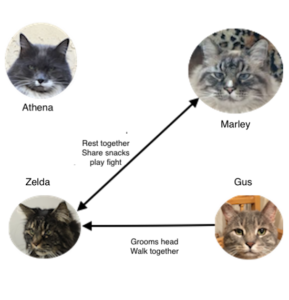
Cats are territorial. What does this mean for cat guardians?
An outdoor cat’s home range is the maximum area he roams and hunts in. Within the home range is a smaller area that the cat will actively defend – his territory. Inside this defended area is a smaller area called the “core territory”, where the cat can rest, has shelter, and feels safe from predators and other cats.
Free-roaming cats establish their territories around food supplies. They remain solitary hunters and don’t share prey with other cats. Access to food, water and places to rest and shelter are some reasons why cats will fight with each other. Having a secure, established territory is essential to the free-roaming cat’s survival.
When cats move inside, their territories shrink and the house becomes the territory. Home ranges still apply for cats with outdoor access. Within the house, cats will choose their core territories – their safe places where they go to nap and feel secure.
What are the threats to the territory of the indoor cat?
- Outdoor cats: Neighborhood cats that come in the yard or come to the windows of the home may be seen as a threat by the indoor resident cat(s). The threatened cat may strike out at humans or other pets nearby because he can’t get at the cat outside but is prepared to defend his territory.
- Other resident cats: Cats are territorial and remain territorial when they are kept indoors. There are often multiple social groups in a multi-cat home. Cats of one social group may guard resources such as litter boxes, food and water from cats of another group.
- People, other animals, inanimate objects: Although territorial behavior usually involves other cats, cats may see other species or things as threats to their resources and well-being, as threats to a secure territory.
You will see your cat rubbing her face against walls and furniture. She is depositing pheromones from glands in her face to mark the area as safe. Cats also routinely mark areas by scratching, releasing another pheromone from glands in their paws, an olfactory signal to other cats that they passed by. This is normal behavior that the cat guardian needs to accommodate by providing scratching post and cleaning the “whisker walls” sparingly. Maintain the colony scent..
If your indoor cat perceives a threat, he may feel the need to mark the house with urine (sometimes feces) to establish the house as his territory. He also may respond to the “threat” with aggression.
It is up to the cat guardian to understand that cats are territorial and ideally modify the environment before marking or aggression starts.
What you can do:

- Outdoor animals: Restrict access to your yard if you can. “Critter spikes” can deter some cats and raccoons from scaling fences. A motion activated yard sprinkler can also be effective. You may wish to cover windows with static cling window film so that cats can’t see out.
- Multi-cat conflict: Identify the social groups in the household. Make sure resources are spread out and all the cats in the household have easy access to resources of their choice. Pay particular attention to the dynamics of feeding, using litter boxes, and resting. Make sure that all cats have an opportunity to exercise their hunting skills through play. Set up time-sharing for social groups if necessary.
- People, other animals, inanimate objects: Isolate your cat from the stressor or desensitize her if possible. For example, if she feels threatened by visitors, train her to go a safe place out of reach when visitors arrive. Request that visitors refrain from interacting with your cat unless she chooses to interact. Make sure to reward her with something she likes in her safe place. She may elect to leave the room or observe from her safe place.

